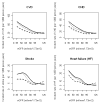Estimated GFR and incident cardiovascular disease events in American Indians: the Strong Heart Study
- PMID: 22841159
- PMCID: PMC3473098
- DOI: 10.1053/j.ajkd.2012.06.015
Estimated GFR and incident cardiovascular disease events in American Indians: the Strong Heart Study
Abstract
Background: In populations with high prevalences of diabetes and obesity, estimating glomerular filtration rate (GFR) by using the Chronic Kidney Disease Epidemiology Collaboration (CKD-EPI) equation may predict cardiovascular disease (CVD) risk better than by using the Modification of Diet in Renal Disease (MDRD) Study equation.
Study design: Longitudinal cohort study comparing the association of GFR estimated using either the CKD-EPI or MDRD Study equation with incident CVD outcomes.
Setting & participants: American Indians participating in the Strong Heart Study, a longitudinal population-based cohort with high prevalences of diabetes, CVD, and CKD.
Predictor: Estimated GFR (eGFR) predicted using the CKD-EPI and MDRD Study equations.
Outcomes: Fatal and nonfatal cardiovascular events, consisting of coronary heart disease, stroke, and heart failure.
Measurements: The association between eGFR and outcomes was explored in Cox proportional hazards models adjusted for traditional risk factors and albuminuria; the net reclassification index and integrated discrimination improvement were determined for the CKD-EPI versus MDRD Study equations.
Results: In 4,549 participants, diabetes was present in 45%; CVD, in 7%; and stages 3-5 CKD, in 10%. During a median of 15 years, there were 1,280 cases of incident CVD, 929 cases of incident coronary heart disease, 305 cases of incident stroke, and 381 cases of incident heart failure. Reduced eGFR (<90 mL/min/1.73 m2) was associated with adverse events in most models. Compared with the MDRD Study equation, the CKD-EPI equation correctly reclassified 17.0% of 2,151 participants without incident CVD to a lower risk (higher eGFR) category and 1.3% (n=28) were reclassified incorrectly to a higher risk (lower eGFR) category.
Limitations: Single measurements of eGFR and albuminuria at study visits.
Conclusions: Although eGFR based on either equation had similar associations with incident CVD, coronary heart disease, stroke, and heart failure events, in those not having events, reclassification of participants to eGFR categories was superior using the CKD-EPI equation compared with the MDRD Study equation.
Copyright © 2012 National Kidney Foundation, Inc. Published by Elsevier Inc. All rights reserved.
Figures

References
-
- Wang F, Ye P, Luo L, Xiao W, Wu H. Association of risk factors for cardiovascular disease and glomerular filtration rate: a community-based study of 4925 adults in Beijing. Nephrol Dial Transplant. 2010;25(12):3924–3931. - PubMed
-
- Shara NM, Wang H, Valaitis E, et al. Comparison of estimated glomerular filtration rates and albuminuria in predicting risk of coronary heart disease in a population with a high prevalence of diabetes mellitus and renal disease: The Strong Heart Study. Am J Cardiol. 2011;107(3):399–405. - PMC - PubMed
Publication types
MeSH terms
Grants and funding
- U01 HL041642/HL/NHLBI NIH HHS/United States
- U01-HL41652/HL/NHLBI NIH HHS/United States
- UL1 RR031975/RR/NCRR NIH HHS/United States
- UL01-HL41654/HL/NHLBI NIH HHS/United States
- U01 HL065521/HL/NHLBI NIH HHS/United States
- F32 DK075204/DK/NIDDK NIH HHS/United States
- U01 HL065520/HL/NHLBI NIH HHS/United States
- U01-HL65520/HL/NHLBI NIH HHS/United States
- U01 HL041654/HL/NHLBI NIH HHS/United States
- U01 HL041652/HL/NHLBI NIH HHS/United States
- UL1RR031975/RR/NCRR NIH HHS/United States
- U01-HL41642/HL/NHLBI NIH HHS/United States
- K23 DK091363/DK/NIDDK NIH HHS/United States
- U01-HL65521/HL/NHLBI NIH HHS/United States
LinkOut - more resources
Full Text Sources
Research Materials
Miscellaneous

